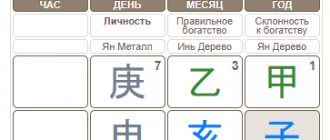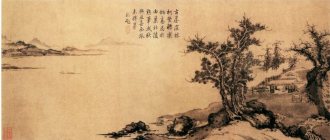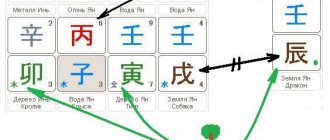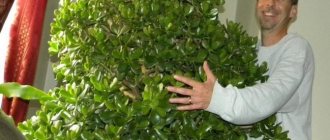Yanskoye Tree
We decided to tell you about the 60 Jia Zi - the 60 pillars of the Chinese calendar, which make up both the calendar itself and the birth chart - bazi.
Let's start with the Yang Tree; the descriptions primarily refer to the birthday pillar.
Yanskoye Tree
The Yang Jia tree is tall, strong and slow growing. People of this celestial trunk are straightforward, reflective and true to principles. They do not open up to others right away, but only when they feel trust. They take care of loved ones. They can be stubborn and not always objective.
Yang heavenly trunks are combined with Yang earthly branches. In the case of Jia, six trunks are formed: Jia Zi, Jia Yin, Jia Chen, Jia Wu, Jia Shen and Jia Xu.
Jia Zi, Yang Tree on the Rat
The image of the pillar is a healthy green tree in the middle of white snow. Water nourishes the Tree, giving the individual a strong will and independence, calm, stability, stubbornness, and discipline. Pillar people are patient, do not like changes, and develop over a long period of time in life, like trees in nature. Surprises and surprises usually confuse them. The character of a Jia Zi person depends on the season of birth. Summer ones are more emotional, while winter ones are calmer in temperament. They are all resilient and resourceful in finding solutions. As a rule, they are confident in themselves and know what they want from life. They avoid crowds of people and find peace and relaxation in nature. They value their personal life, but are able to well understand other people's problems. They can give the right advice, appreciate everything good and prefer to be in harmony with their conscience. They know how to earn money, they are thrifty, thrifty.
The Rat gives the Jia Zi person charm, charisma, intelligence and intelligence. These people know how to communicate and make friends, need reliable loved ones and have a very difficult time coping with losses. They learn easily and with pleasure, and are very energetic. The Tree gives them kindness and caring, and the Rat gives them tolerance and a willingness to forgive. However, the Yang Water of Rats often makes them overly sensitive, prone to depression and brooding.
Jia Yin, Yang Tree on the Tiger
It is the strongest, most stubborn and most stable of all yang trees. People of this pillar are observant, cautious, and intelligent. They are characterized by loyalty, reliability and physical endurance. They are persistent, honest, ambitious, straightforward and self-confident. They have strong intuition and rely on it when they need to make a serious decision and understand people. A positive outlook on the world gives them optimism and helps them see the good. Their personality is often dual: they can be tough and understanding, selfish and generous at the same time.
It's always interesting to be with them, they are honest, open, energetic, and a little sentimental. They love to be the center of attention and have leadership qualities. They always take care of their appearance. The tree gives them generosity, generosity and the ability to forgive, but at the same time they never forget insults. They rarely change their minds; they like clarity in affairs and relationships. Sometimes they are characterized by pride and a sense of superiority. Like the Tiger, they are outwardly calm, but internally focused and ready for a fight. They can be aggressive and strive for competition. They don't like to lose, and failure can cause depression. They are brave, stubborn, practical. If they recognize the leadership of another, they are ready to obey and become excellent performers. They value the approval of friends and relatives and become good parents. It is important to teach the Jia Yin child respect and respect for boundaries, because... Such children naturally strive to dominate.
Jia Chen, Yang Tree on the Dragon
This Tree is beautiful. It grows on the large fertile Chen Hill, its powerful roots are fed by water hidden in the ground, it has a thick trunk and a lush crown. It reigns over its land, receiving support and nutrition from it. Jia Chen people are confident and happy. They are persistent, competent in their field, reliable and honest. People around them appreciate their diplomacy, responsiveness and participation. Jia Chen are generous, fearless, and ready to solve difficult problems. They love risk and have subtle intuition. These are people with an inner core; they have their own principles and courage to follow them. It is to Jia Chen's people that others often come for advice and help.
Jia Chen are creative, prone to out-of-the-box thinking, and ready to bring their ideas to life. They are always talented in what they do, freedom-loving, love travel and discovery. Failures strengthen them. Appearance is important to them, they don't like to rush and can be a little sentimental. Being extroverts, they strive to communicate and are sometimes extravagant.
Jia Chen clearly expresses their opinions, but few people talk about their feelings. They don't like asking for help, don't want to learn from other people's mistakes, and don't take criticism well.
Jia Wu, Yang Tree on a Horse
A tree bathed in the Sun—this is the image this pillar gives birth to. Jia Wu people tend to be thoughtful and compassionate, but can also be tough. They are brave and ready to help the defenseless. They have an inner core, value harmony, peace and are able to enjoy little things. They love good humor, sometimes dark. Creative, emotionally sensitive. At the same time, they maintain an independent opinion and know how to motivate others. They are smart, capable of analysis, strive for new knowledge and become interesting authors and interlocutors. They are practical, inquisitive, see opportunities and are focused on success. However, when working in a team, other points of view may be ignored, which causes disagreements. Their stubbornness and arrogance often lead to problems.
In any situation, Jia Wu retain their individuality and do not miss the opportunity to show themselves. Their charm can border on eccentricity, self-confidence and even some impudence. They are full of creative energy and can be openly proud of themselves and their successes. Over the years they can delve deeper into spiritual development.
Jia Shen, the Yang Tree on the Monkey
Jia Shen is a Tree, magnificent in its golden autumn attire. Pillar people are usually cheerful, expressive, witty, and charming. They are easy to communicate with, easy to understand, quick to think and quick to act. Charming externally, harmonious internally, they are often loving. If there is cunning in Jia Shen’s character, then they will be able to turn any situation in their favor. In this case, it may be difficult for open and direct people to communicate with Jia Shen, but for some professions this quality turns out to be useful.
Jia Shen are practical, see opportunities, and know how to plan. They can be excellent inspirers and effective leaders. They are determined, fearless, dynamic, strong, not afraid of difficult tasks, and know how to improve their skills with their help. They are often successful and are not afraid to face challenges. They know how to give the right smart advice to their loved ones, often helping them in their careers and personal lives.
Jia Xu, Yang Tree on a Dog
This is a tree growing on the rocky mountains. This pillar of the day usually goes to strong individuals with independent character and ambition. They are decisive, creative, and infect others with enthusiasm. They are characterized by dynamism, they can have unusual hobbies and support non-standard opinions. They are stubborn, practical, but can also become good negotiators. They are often loners by nature, but can also be productive in a team. Despite their high opinion of themselves, they are attractive and interesting to other people. They are attentive to appearance, have good intuition, and are true to themselves and their loved ones. They are caring and can volunteer or do charity work. Conceit is often combined with sensitivity, so they have to look for balance within themselves and struggle with emotions. They may fall under the influence of others. An active need for self-expression can cause hostility from rivals. Jia Xu does not accept doubts about their freedom and independence. They do not look for easy ways, they strive to test their strength, they love traveling and meeting different people. They are able to think strategically, quickly find effective solutions, but sometimes suffer from perfectionism and are immersed in unrealistic dreams.
They are selfish and do not tolerate defeat well. They are often led to failure by their own stubbornness and refusal to listen to others. Jia Xu is capable of earning money, but due to wastefulness, it is difficult for him to keep what he earns. Therefore, in the first half of life, while they strive for quick success, they may have financial problems.
More about the 60 pillars (Jia Zi)
Chada Oshun and Shango
This element includes trees and woody shrubs.
The element itself is dark green or emerald in color, viscous, oily.
is born in the month of the Pig. In our latitudes, this month starts at the beginning of November and lasts until the first days of December, and it is quite strange to talk about the birth of a Tree in the midst of the November cold and gloomy sleeping trees. And yet, the bare trunks and branches of trees in our latitudes during this period are not dead and insensitive. Active life occurs in the roots of trees, which go deep underground; metabolic processes continue in the remaining parts of the tree.
Bathing phase of the Yang tree occurs in the Rat (December). Now is the time for water treatments, yes. This name of the phase is associated with the logic according to which the newborn baby is immediately washed, washing away the blood and mucus with which he is surrounded immediately after birth.
This phase of Qi is considered the most intimate and secret. In our latitudes, trees are at rest in December - January, but they consume quite a lot of moisture, especially during strong winds, and indeed, they seem to bathe in it to warm themselves.
In Ox (January) the Yang tree begins the Hat and Belt . This phase is compared to apprenticeship in school. The phase is considered quite high and active. In the midst of January frosts, which usually occur in our climatic latitude, it is very difficult to discern the high, vigorous phase of qi. But if you cut a couple of branches from any tree, especially a fruit tree, and put them in water, you will see that buds have actively begun to grow on them, they are growing. In November - December you will not get this effect. In addition, without December/January frosts, trees will not be able to bloom normally when spring arrives. So we can say that having received the student’s hat and belt in the month of the Ox, the trees are actively learning and hardening for future flowering and growth.
In the month of the Tiger (February), the Yang tree enters the Qi phase of Entering Service . This is no longer a school student, but a graduate student or a young specialist ready to build his career.
February, even shrouded in severe frosts, is still distinguished by blue skies and warm sun rays, although not hot enough to melt the ice, but the warming process starts in full force. It is not so difficult to notice that trees wake up in February. The first green buds appear on many, although not on all branches at once; if you cut a branch, you can see that it is full of juices.
phase of the Imperial Lamp occurs in the month of the Rabbit (March). This is the highest possible phase of Qi. It is followed by a slow decline. In the month of March, all the resources of the tree stored since autumn are released and put into use, all tissues and organs begin to grow and develop, preparations are made for the flowering and fruiting phase. The entire potential of the tree is in demand and is distributed.
In the month of the Dragon (April), the Weakening phase begins for the Yang tree . This is a quite vigorous stable phase. In April, usually many trees bloom wildly, or lay buds of future flowers; in some organs and tissues the first small portions of reserves for future cold weather can be deposited.
In the month of the Snake (May), the Yang tree steps into the phase of Disease . Despite the name, this is also quite a vigorous, strong phase. In May, some trees are just blooming, others are already bearing fruit, and the tree’s powers are ready to flow into future seeds and fruits.
In the month of the Horse (June), the Yang tree enters the phase of Qi - Death . It sounds creepy and strange. If you look outside the window, you will most likely see the lush greenery of trees, completely alive and healthy. But nevertheless, the growth of the tree begins to slow down, the shoots become woody, the phase of starch accumulation begins to accelerate, and all the energy of the tree is finally concentrated in future fruits.
In the month of Goat (July), the Yang Tree goes to the Grave . There it prepares for the next birth. In July, the fruits actively ripen and seeds are formed. But the tree itself practically does not grow, no significant changes occur in it.
In the month of the Monkey (August), the Yang Tree enters the lowest possible phase - the phase of Decay . Trees in our latitudes, having entered the dormant phase in mid-summer, can no longer begin vigorous vegetative growth and another development cycle. In the Decomposition phase, some trees are already shedding fruits or are beginning to do so, and within them there are processes of preparation for renewal and sorting of stored nutrients.
In the month of the Rooster (September), the Yang Tree enters the Embryo . Firstly, most trees have already completely lost their fruit. And the energy of the Yang Tree in a dormant form is in them. And the trees themselves begin to process stored starch into sugars; their root system becomes active. So the Qi energy accumulated in the past leaves with the fruits this month, and the mature trees themselves undergo a transformation in order to renew themselves.
In the month of the Dog (October), the Yang tree enters the Nutrition . Trees prepare and store nutrients, and there is a high phase of activity of absorbent roots. So the trees are actually actively feeding during this phase in order to prepare for the coming winter.
Madara(c)
Share on Facebook Share
Share on Pinterest Pin it
Share on TwitterTweet
Six Personality Types Yang Tree
60 Jia Zi
Yan Tree People
persistent, responsible, straightforward. Have difficulty adapting to changing situations. They have firm, clear intentions. Usually such people know well what they want in life and are results-oriented. Having set a goal, they consistently pursue it. They strive for development and self-improvement. They are passionate about new trends and trends, strive to be at the top of progress. They often make good politicians and athletes.
There are six types of Yang Tree
| 甲 | 甲 | 甲 | 甲 | 甲 | 甲 |
| 子 | 午 | 寅 | 申 | 辰 | 戌 |
甲子Yang Tree on the Rat. People are independent, freedom-loving. They learn easily and perceive information well. They often enjoy the learning process. Creative, have creative talents and abilities. Smart, thrifty people. They have a sense of self-esteem. They have respect and authority among people. They look for support in their partner and happily delegate all the chores to their spouse. They love variety and cannot stand routine or monotonous activities.
甲午Yang Tree on a Horse. These are bright people. Good-natured, cheerful. They love novelty and change. They have quite original thinking. Their striking feature is courage, determination, courage. They are ready to help others, but they themselves do not ask for help and may even refuse it. People with this pillar are often noticeable and sexually attractive. Women attract the attention of men and often the hostility of other women who perceive her as competition. A woman may have a strong maternal instinct.
甲寅Yang tree on the Tiger. People are leisurely, striving for stability, do not really like change, and are inflexible. They always decide for themselves what they need. They will only study what they consider important. They strive for development and are interested in non-standard approaches. They have an active life position. They interact well with people. They value friendship. They motivate people and can assemble a strong team. They have high self-esteem and a sense of self-worth and self-confidence. Able to overcome obstacles, defend rights, fight. Relationships with a partner are built on equal terms.
甲申Yang Tree on Monkey. They learn very quickly and absorb information well. Quite hot-tempered, easily involved in arguments and fights. Adapts well to change. Witty, with original ideas. They are often tough and domineering. They make good leaders and bosses. Quite ambitious. They know how to move prudently towards the goal. May be unstable. Such a pillar changes its characteristics quite significantly depending on other elements in the map.
甲辰Yang Tree on the Dragon. People are balanced and generous. Not very flexible, sometimes it is difficult for them to adapt to changes in life. Smart, educated people love to leisurely study a wide variety of information. They have good self-control. They know how to assemble a team. Able to influence the lives of other people. They have good intuition and are often interested in non-standard practices, including esotericism and mysticism. At the same time they are very practical. They combine the ability to look at things soberly and at the same time the ability to think creatively. They need to develop their abilities and intuition; with the help of these qualities they can earn good money.
甲戌Yang Tree on the Dog. By nature, fighters fight for their interests. Brave and active, very resilient and hardworking. Sociable people. Use information well and correctly. Excellent at motivating people and developing strategies. They prefer to work alone. They have a competitive spirit. Ready to take responsibility. They have a strong material interest, although often in life they have to go through difficulties and obstacles in order to achieve their goal.
Each of the sixty Jia Zis is a whole layer of information about the character, abilities, and life opportunities of a person. The most complete information about the 60 Personality types described by Jia Zi in the new version of the 60 Jia Zi Handbook.








